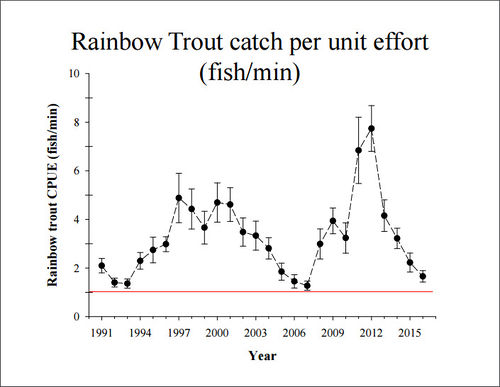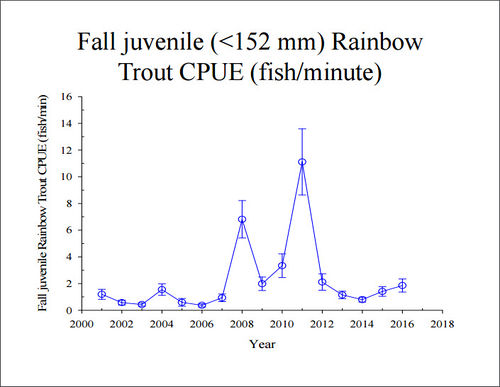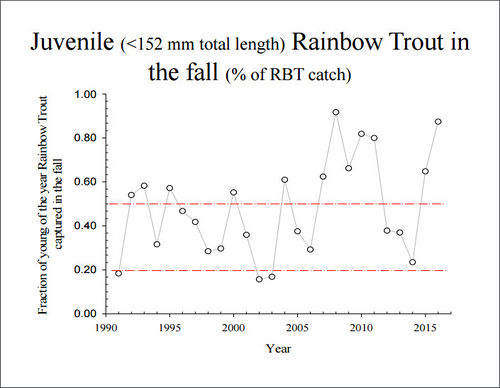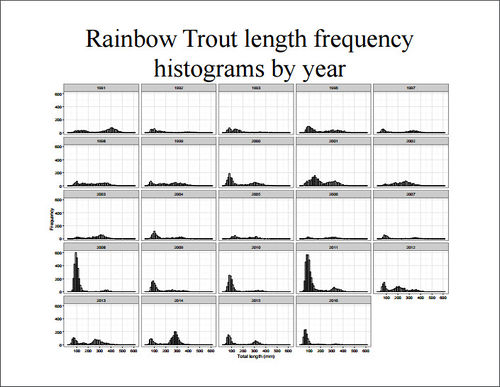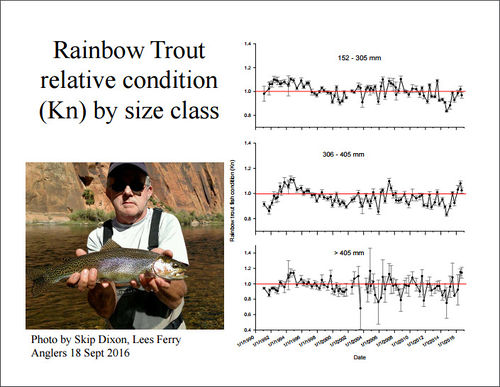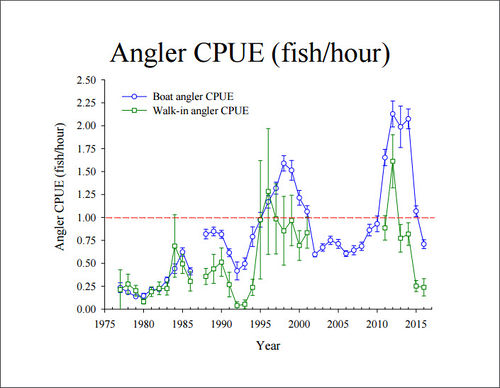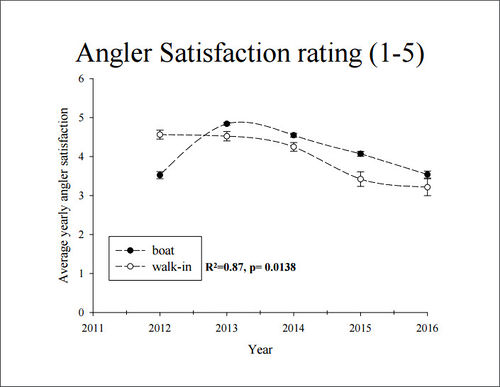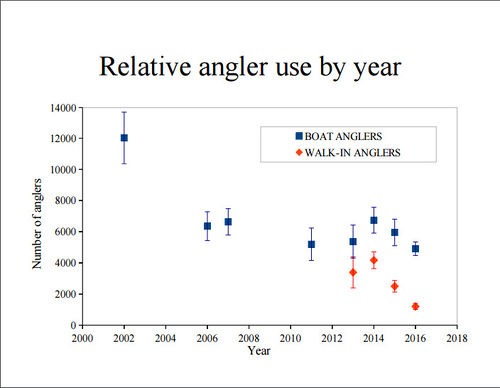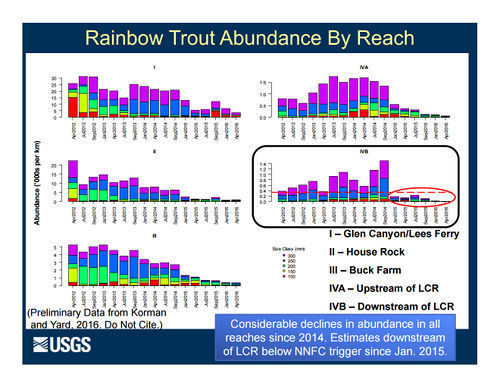Difference between revisions of "FISHERY"
Cellsworth (Talk | contribs) |
Cellsworth (Talk | contribs) |
||
| Line 224: | Line 224: | ||
[http://gcdamp.com/index.php?title=Quagga Quagga mussels] have become established in Lake Powell and we are now seeing some in the river below the dam. Their arrival in the river happened sooner than I expected. So far, there has not been a major infestation and there is some thought by experts that they will not become very well established in the river due to the current. Be aware and remember to dry waders and boots before using them in any other body of water. Also, all private boats should drain all water from the boat and live-wells as soon as you exit the river. We all need to do our part to limit the transport of this and all invasive species. | [http://gcdamp.com/index.php?title=Quagga Quagga mussels] have become established in Lake Powell and we are now seeing some in the river below the dam. Their arrival in the river happened sooner than I expected. So far, there has not been a major infestation and there is some thought by experts that they will not become very well established in the river due to the current. Be aware and remember to dry waders and boots before using them in any other body of water. Also, all private boats should drain all water from the boat and live-wells as soon as you exit the river. We all need to do our part to limit the transport of this and all invasive species. | ||
| + | |||
| + | |- | ||
| + | ! <h2 style="margin:0; background:#cedff2; font-size:120%; font-weight:bold; border:1px solid #a3b0bf; text-align:left; color:#000; padding:0.2em 0.4em;">[http://gcdamp.com/index.php?title=Bishop_Study Bishop Study and River Recreation Preferences]</h2> | ||
| + | |- | ||
| + | |style="color:#000;"| | ||
| + | |||
| + | In Bishop et al. (1987; on page 410 of the 30 page report: “Grand Canyon Recreation and Glen Canyon Dam Operations: An Economic Evaluation) fluctuating flows are defined as any operation where the daily flow fluctuation was equal to or more than 10,000 cfs/day. Bishop treated daily flow fluctuations of less than 10,000 cfs/day as “constant flow releases.” Bishop identified that this “10,000 cfs threshold was determined to be the point at which fluctuations begin to be perceptible to recreationists.” <br> | ||
| + | |||
| + | Additionally, Stewart et al.’s (2000) follow-up of the Bishop et al. (1987) study found that angler’s did not identify river level fluctuations, at least under the MLFF operating regime, as an issue. Based on information from Stewart et al (2000) and Bishop et al. (1987), '''any flow fluctuation below 10,000 cfs/day should be treated the same as a steady flow release'''. | ||
| + | |||
| + | *[http://www.gcmrc.gov/library/reports/cultural/Recreation/Stewart2000.pdf The Stewart Report: Preferences of Recreation User Groups of the Colorado River in Grand Canyon. 2000] | ||
| + | *[http://www.swrcb.ca.gov/water_issues/programs/ocean/cwa316/docs/cwa316may2010/comments041310/bishop_etal.pdf The Bishop Study: Grand Canyon Recreation and Glen Canyon Dam Operations: An Economic Evaluation. 1987. pg 407-436 ] | ||
| + | *[[File:1987 Bishop GCDam releases downstream rec analysis user pref.pdf| The Bishop Study: Glen Canyon Dam Releases and Down Stream Recreation: An Analysis of User Preferences and Economic Values. 1987. Report to GCES. 398 pgs. ]] | ||
|- | |- | ||
Revision as of 12:55, 24 January 2019
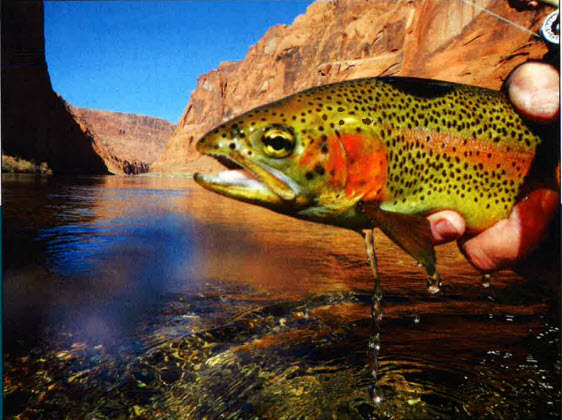 |
The Lees Ferry Rainbow Trout FisheryIn 1964, the Lees Ferry tailrace on the Colorado River was given birth by the completion of Glen Canyon Dam, which impounded Lake Powell. Subsequent water releases from the bottom of Lake Powell changed the once highly turbid, warm waters of the Colorado River into a constant cold (46-50°F), clear flowing river. Shortly after completion of the dam, the Arizona Game and Fish Department stocked rainbow trout (Oncorhynchus mykiss) in the 15-mile Lees Ferry reach and, in 1981, began to manage this section of river as a Blue Ribbon rainbow trout fishery. The trout began to flourish in the Lees Ferry reach from 1970-1985 when catches of rainbow trout above 10-pounds were not uncommon, and angler pressure was relatively low. In 1991, however, the Bureau of Reclamation implemented the Record of Decision flow regime, which consisted of higher minimum and more stable flows and allowed for increased trout reproduction and survival. Under these conditions, a huge population of trout developed causing individual fish growth rates to decline. Quite simply, there was a large number of fish competing for limited space and food items, resulting in a fishery where trout less than 14-in were dominant. In 2000, the Arizona Game and Fish Department began a long-term monitoring program sponsored by Grand Canyon Monitoring and Research Center to determine the effects of Glen Canyon Dam operation on the trout fishery at Lees Ferry and to make recommendations for improving this fishery. Since 2000, our data collection has shown an increase in the general health of all trout age classes (especially since 2002). This increase in fish health is usually associated with an increase in growth rates. There has been a marked increase in catch rates of young-of-the-year fish in recent years. With successful spawning and recruitment continuing to occur, fishing conditions in Lees Ferry are improving. [1] LTEMP Resource Goal for the Rainbow Trout FisheryAchieve a healthy high-quality recreational rainbow trout fishery in GCNRA and reduce or eliminate downstream trout migration consistent with NPS fish management and ESA compliance. Desired Future Condition for the Lees Ferry Trout FisheryA high quality trout fishery in GCNRA, as further described in the Recreation DFC that does not adversely affect the native aquatic community in GCNP. |
| Rainbow Trout | Brown Trout |
|---|
|
Visitor Use and Experience
HISTORY
Additional Links
|
